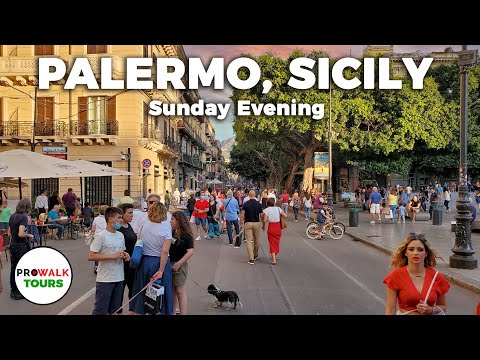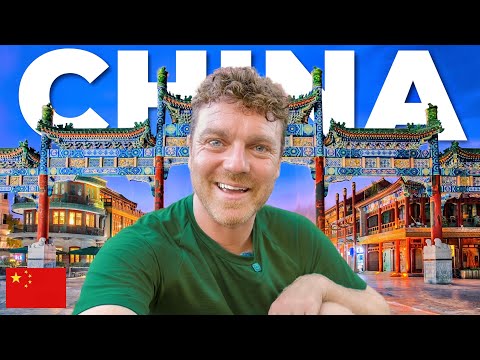Palermo, Sicily Sunday Evening Walk - 4K - June 21st, 2020

Welcome to Palermo, the capital of Sicily. This walk begins at the Piazza Quattro Canti on Via Maqueda, also known as “Strada Nuova” (New Street). Here at the Piazza Quattro Canti, Via Maqueda meets up with the other main historic street in Palermo, Via Vittorio Emanuele, better known as the Cassaro.
Together, the two streets form a cross and are nicknamed “Croce Barocca” (the Baroque Cross). The piazza is octagonal in shape, with the streets as four sides and the buildings as four sides. The buildings around the piazza date back to between 1609 and 1620. This street was built between 1577 and 1599 as part of a large scale urban renewal project of Palermo. The intersection we just passed through created four distinct districts in Palermo: La Loggia, Il Capo, Kalsa and Albergheria. As of 2014, this section of the street between Quattro Canti and the Teatro Massimo has become pedestrian only.
The street has been transformed into the main promenade of the city, favoring the opening of many new businesses. While here in Palermo, I also filmed a day walk and a bike ride which will both be posted to the channel soon. You can click on the link in the video description to see a map of this walk. There is also a link in the video description that will take you to a map showing you the location of every walk posted on the channel, organized by date and country. In this video, you are joining the locals on their evening stroll, known as a passeggiata, through the historic center.
The daily passeggiata usually takes place between 5 and 8 pm and is most popular on the weekends. There is no special event happening or reason to be out other than to enjoy an evening walk with the rest of the locals as the city comes alive. This is the Galleria Delle Vittorie, built in 1935. It has been neglected for several years and only reopened in 2014 with a restaurant and a pub inside. I should have gone inside. Sorry about that. Now for some brief history on the "Most Conquered City in the World." The city of Palermo was founded in 734 BC, by the Phoenicians. For context, Rome was founded in 753 BC.
The Phoenicians were a civilization that originated in the Levant region of the eastern Mediterranean, primarily modern Lebanon. They set up trading posts all around the Mediteranean between 1500 and 300 BC. And now you can even get "The American Coffee Experience" here at Starbucks, I mean, Pedro's Coffee! The Phoenicians named this town Zyz (Ziz), meaning flower. Zyz was also a popular destination for the Greeks, who came to dominate a large part of Sicily. The Greek’s name for Zyz was Panormos, “all-port”, and this is the name that caught on around the Mediteraean.
Throughout its 3,000 year history, Palermo has become known as the “Most Conquered City in the World." The Phoenicians remained in control until 258 BC, when Palermo was taken over by the Romans. The Romans remained in power until 535 AD when Palermo was liberated by the Byzantines. This was a peaceful time for Palermo which lasted until 831 AD when the Arabs took over Sicily and made Palermo a capital in their Sicilan emirate. The Arabs ruled for about 120 years and their dominion over the island left a lasting impact on Palermo from the architecture, to the food and even the language.
We are now approaching Piazza Giuseppe Verde and the Teatro Massimo. During my day tour of Palermo, I will take you on a tour of the Teatro Massimo. It is pretty impressive inside! It is believed that the Arab influence was the most culturally significant in the history of Palermo. This is the end of the pedestrian zone. For those of your who are concerned about so few people wearing masks, Sicily had very few cases of covid during the first wave. At this time, there were only around 200 known cases on the island of Sicily. The Teatro Massimo, built between 1874 and 1897, is the largest opera house in Italy.
The theater closed in 1974 for renovations and due to corruption and political in-fighting, it remained closed for 23 years. It finally reopened in 1997, four days before its centenary. The final scenes of the Francis Ford Coppola's film The Godfather Part III (1990) were filmed at the theatre. My tour will take you to the exact location. After a 5 year siege, the Arabs were finally defeated by the Normans in 1072 AD.
German rule over Palermo soon followed, then the Swabians, followed by the Angevins and then Aragonese. Between 1479 and 1734, Palermo was ruled by the Kingdom of Spain, Savoy and Austria. When the Kingdom of the Two Sicilies was founded in 1816, the original capital city was Palermo but a year later moved to Naples.
This Baroque church was built between 1598 and 1622. Bourbon rule over Palermo ended in 1861 with the Landing of Garibaldi and the Unification of Italy. Being the capital of Sicily, Palermo is the center for much of the region’s finance, tourism and commerce. Walking around all day these cities, I tend to meet people that I end up seeing many times. Palermo is also home to the Sicilan Mafia and there is still a high level of corruption and a significant black market empire here.
During WWII, Palermo’s historic city center was severely damaged by Allied bombing raids. Nearly 150,000 people were displaced because of the raids and forced to live in crowded slums, shantytowns and even caves. Between 1950 and the mid-1980s, Palermo experienced an era of unregulated construction, what is now referred to as the Sack of Palermo. During my day tour of Palermo, I will take you to a rooftop terrace on the building across the street with views of the piazza below.
Across the street is the Church of Saint Dominic, built between 1640 and 1770. The church hosts the burials of many figures of Sicilian history and culture. For this reason it is known as the "Pantheon of illustrious Sicilians". This street was quite crowded during the day and full of life. I thought it would be just as popular at night. I was wrong.
We will walk through this empty street and come out at Via Vittorio Emanuele, the main street through Palermo, and the one the meets Via Maqueda at the Piazza Quattro Canti. We will be back at the Piazza Quattro Canti at time 31:30. During the Sack of Palermo, the infamous Vito Ciancimino gave thousands of building permits to mafia frontmen, turning much of Palermo into an “ugly concrete jungle.” Many parks and historic villas were destroyed during this time. In one case, a large historic villa was destroyed in the middle of the night, which led Giovan Battista to resign from the public works commission in protest. Today there is a car wash located where the historic villa once stood.
This street dates back to the original Phoenician settlement of Zyz nearly 3,000 years ago. This is Via Roma. It runs parallel to the pedestrian street, Via Maqueda. These corrupt city planners during the 1960s tried to convince the public that green spaces and public parks did not belong inside the city, claiming that Palermitan children didn’t like grass. For decades, there had been a denial of any kind of organized crime or Mafia, but this changed with the increase in murders of city judges and police officers.
By the 1980s Italy officially recognized the existence of the Mafia. This streets goes right past the Cathedral of Palermo and the Norman Palace, both of which you will see during the day tour of Palermo. From 1951 and 1981, with the increase in low income housing, the population of Palermo also increased by 41% from 503,000 to 709,000. We are now back to where the tour began.
We will walk down to the Teatro Massimo along Via Maqueda one more time. Today, Palermo is the sixth most populated city in Italy with a population of 676,118. It is the largest city south of Naples, which has a population of one million. Due to its location in the Mediterranean, as well as being surrounded by mountains, Palermo has some of the best weather in all of Europe.
The patron saint of Palermo is Saint Rosalia, a noble who lived as a devout Christian in a cave on Mount Pellegrino in the 12th century. When the plague was wreaking havoc in Palermo, people starting seeing visions of Rosalia. One of the visions told a hunter where to find her remains and he paraded them through the city. Afterwards, the plague left the city and Rosalia was venerated as the city's patron saint. Their patron saint day occurs each year on July 14th. That was one week before this was filmed. Before 1624 Palermo had four patron saints, one for each of the four major parts of the city. They were Saint Agatha, Saint Christina, Saint Nympha and Saint Olivia.
I really enjoyed my time here in Palermo. I have been living in Naples for the last six year and Palermo reminded me a lot of Naples. Again, to see a complete list of all my walks, you can click on the link in the video description. If you are curious as to why I waited so long to post this video, I try to post one video per week and I filmed about 40 walks over the summer of 2020.
Please be sure to "SMASH THAT LIKE BUTTON!" This really helps out my channel and would be greatly appreciated. Thank you!
2021-04-12 03:52


